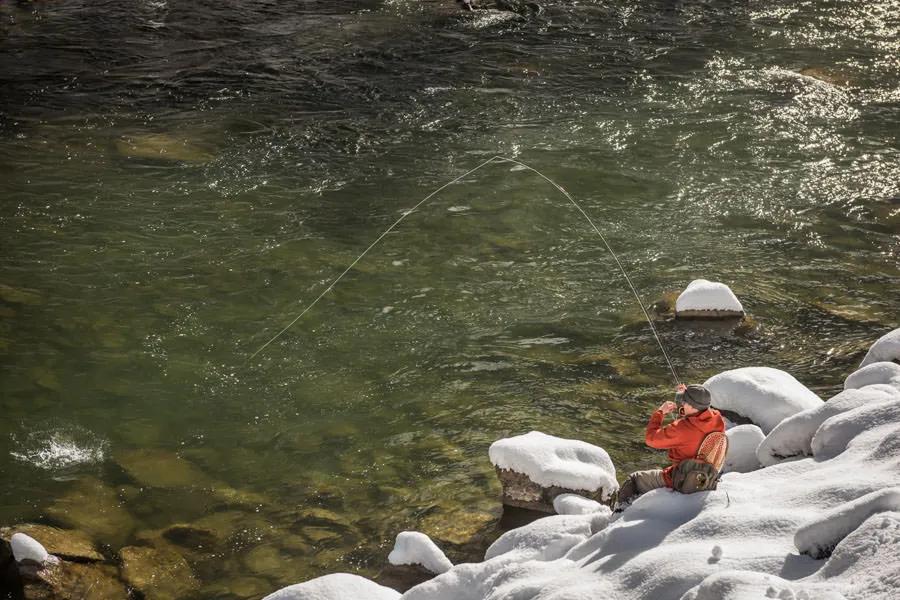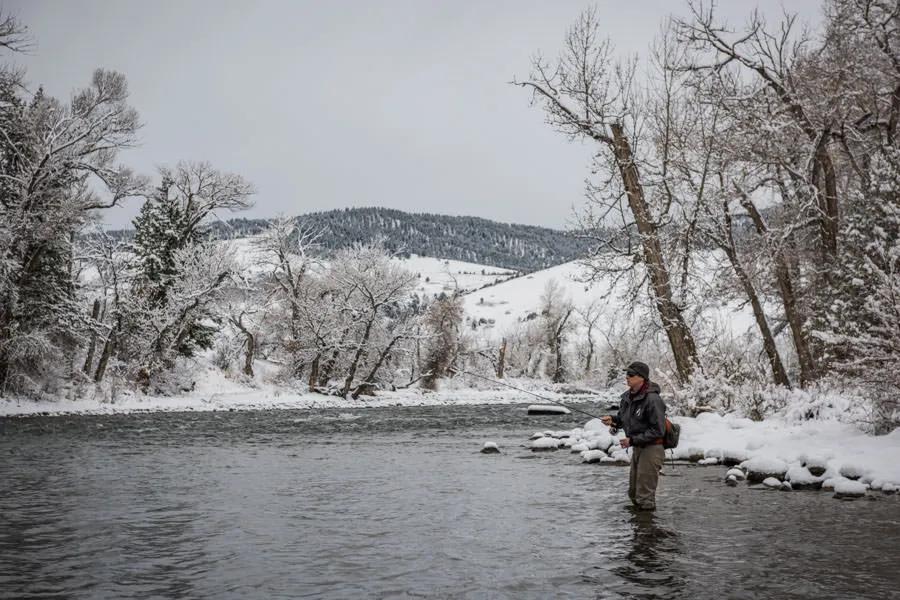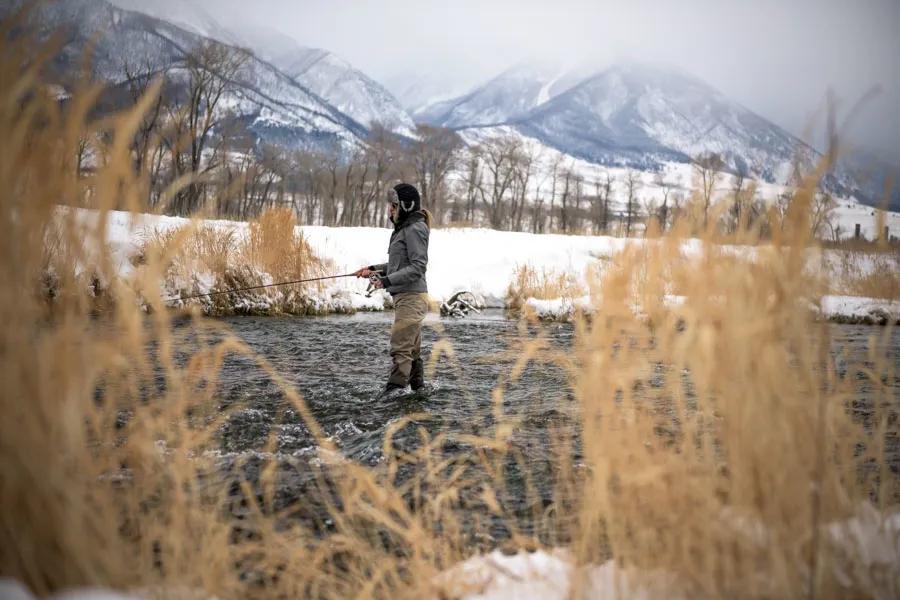
The quintessential picture of fly fishing in Montana is often long summer days with blue skies, sun-tanned anglers, and prolific hatches. Fly fishing in winter provides adventurous anglers unique opportunities that do not exist when the weather is warm and the living is easy. For those willing to brave the cold, the rewards can be a mix of extrinsic and intrinsic--extrinsic because plenty of fish can be caught and intrinsic because the wintry weather keeps the causal anglers on the couch. Being brave and brash to fish in snow, sleet, and freezing-like conditions can be a matter of having the will, and proper gear, to endure, but catching fish in winter requires some specialized skills that go beyond just being dressed appropriately and having a good attitude. For many of Montana fly fishing rivers, winter fishing can be rewarding. Here are some Winter Fly Fishing Tips That Go Beyond Just Dressing Warm.

Keep Your Fly Selection Simple
The types of food available to trout in most rivers is limited in winter. A trout's diet from late November through February consists of mainly subsurface nymphs and the occasional baitfish. Because a trout's need for calories is greatly diminished in winter, most trout feed exclusively on insects. When winter fly fishing in Montana or anywhere trout swim, you can reduce the amount of patterns you choose to a few proven successful ones. Be sure to have a selection of zebra midges, small stonefly patterns such as Pat's Rubberlegs or King Prince's, firebead and hotbead nymphs and worms, and beadhead mayfly nymphs such as Pheasant Tails, Little Green Machines, or Lightning Bugs. Carrying this variety of fly patterns means you will be covered for the bulk of fly patterns for fly fishing for trout in winter. For more information be sure to read "Winter Fly Fishing in Montana: The Only Flies You Will Ever Need."

Embrace Subsurface Nymph Fishing
Because nearly all of the available food for trout in winter swims near the bottom, a trout feeds almost exclusively subsurface. Trout can rise to feed on midges but the emergences have to be very strong. If you want to enjoy the solitude of angling in winter and couple that with bringing some fish to hand, you must embrace going deep. Whether you choose to fish subsurface nymphs via a tight-line method or by using a strike indicator, improving your ability to read water, understand current speed, and adjust for depth changes are crucial to getting the fly in front of feeding fish. Reading water is the ability to look at a section of water and know where trout might be located. It allows you to visually dissect a stream to find fish. For example, by reading the surface of the water and determining that two currents are mixing, you know where to place your fly. Additionally, reading water allows you to watch how water collides with bankside or mid-river structure such as rocks, logs, and other structures. By looking at the currents coming off the bank, you can determine if you need to place your fly at, near, or off the bank. Be sure to watch this great video on How to Fish a Double Nymph Rig.

Learn a Water Haul/Tension Cast and Open Your Casting Loop
Because much of the fishing in winter will be with weighted flies or with rigs with weight added to the leader, being able to cast your rig without tangling is important. Of course to catch fish you need your flies to be in the water and if you are tangled, your flies are in your hand getting fixed and not in the water. Casting with a wider loop and using a tension cast are two techniques that effectively get the flies to the fish while reducing the risk of tangling during your cast. A water haul/tension cast is also a good cast to use when an obstruction exists behind you and a traditional backcast is not possible. To accomplish a water haul/tension cast begin by allowing the current to carry the fly line downstream of your standing position. Once the line has straightened downstream, use the tension of the current on the fly line to help you reposition the line upstream. Raise your rod hand to about head height and turn your palm upward to the sky. Then accelerate the rod forward and stop it as if in a normal forward casting motion. If you are in a boat, the cast is performed in two parts—first, use a “reverse” tension cast by starting with the fly line downstream and in front of you, then accelerating into a back casting motion, allowing the fly line and flies to land on the water behind you. Then, with a very short pause, go into a forward cast while the tension of the current behind you on the fly line and flies helps you reposition the forward cast. To learn more casting tips check out the Montana Angler advanced casting videos.

Understand the Forecast
The feeding habits of trout in winter run in tandem with localized weather conditions. To have more success when fly fishing in Montana in winter be committed to following the weather forecasts. If daily high temperatures stay below freezing for more than a day or two, trout are going to be more lethargic compared to when daily high temperatures rise into the high 30 degrees F or rise into the low 40 degrees F. When considering going fly fishing in winter always check the weather. Fishing during rising temperatures is almost always going to be better than when fishing during dropping temperatures. The lone exception for fishing during a drop in temperatures could be at the very beginning of a cold front passing through as the trout may sense the impending colder conditions and can often feed with higher intensity the few hours before temps drop. Sunshine, or lack of sunshine, is an important factor in the success of fly fishing in winter. The forecasts at NOAA.gov forecast the percentage of sky cover. This is found in the Hourly Forecast section of the forecast. By planning your fishing around the amount of sky cover is important. Sky cover in the evening often means warmer nighttime temps. A clearer sky during the day could mean warmer water temperatures as the sunlight penetrates the water. The ideal forecast for fishing in winter is for temps to not dip far below freezing, cloud cover overnight, and some sunshine during the midday and afternoon hours. In terms of temperatures, the sweet spot is nighttime lows stay above freezing and daytime highs stay above 38 degrees and winds are calm.

Location, Location, Location
Saving the best bit of advice for last is to choose your river wisely. Spring creeks and tailwaters like DePuy's and Armstrong's or the Missouri or Madison Rivers are going to have the most consistent winter fishing options. Spring creeks are streams in which the water emerges from the ground at a consistent temperature year-round. This consistency means insect life is active year-round and trout may feed with a little more activity then on a freestone river. Tailwater fisheries emerge from dams so water temperatures remain relatively consistent as well. Freestone rivers like the Smith River are often more influenced by frigid temperatures and are temperamental in winter. The Gallatin River near Big Sky and Bozeman has a few sections where springs enter the river or submerged springs exist, creating sections where they act more like spring creeks or tailwaters and can provide relatively consistent fishing even in the harshest winter conditions. When choosing where to fish in winter, checking local fishing reports is always a good first step.
